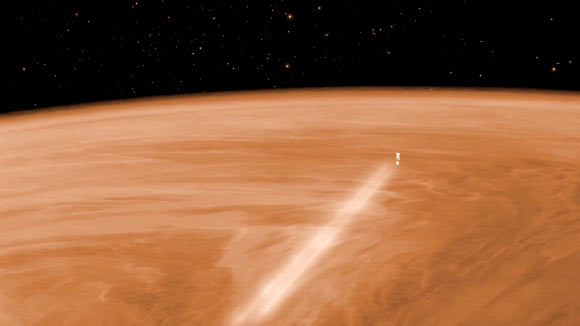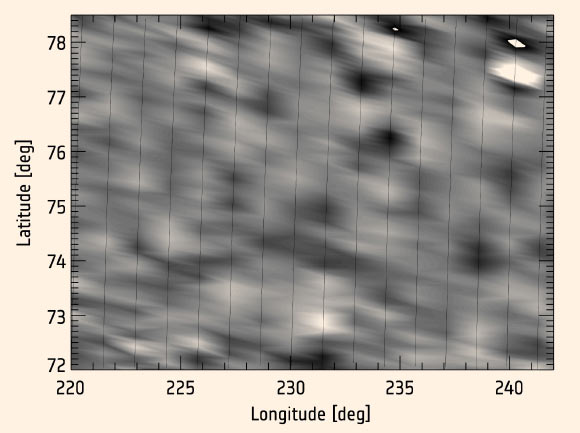Strong atmospheric gravity waves dominate the polar regions of Venus’ atmosphere, according to measurements made by ESA’s Venus Express spacecraft during aerobraking in June – July 2014.

Venus in real colors, processed from Mariner 10 images. Image credit: Mattias Malmer / NASA.
ESA’s Venus Express arrived at Venus in 2006. It spent eight years exploring the planet from orbit, vastly outliving the mission’s planned duration of 500 days, before running out of fuel.
The spacecraft then began its descent, dipping further and further into the Venusian atmosphere, before the mission lost contact with Earth in November 2014 and officially ended in December 2014.
“Previously, our understanding of Venus’ polar atmosphere was based on observations gathered by NASA’s Pioneer Venus probe in the late 1970s,” said Dr. Ingo Müller-Wodarg of Imperial College London, UK.
“These were of other parts of Venus’ atmosphere, near the equator, but extrapolated to the poles to form a complete atmospheric reference model.”
The new measurements, taken as part of the Venus Express Atmospheric Drag Experiment (VExADE), have now directly tested this model – and reveal several surprises.
Venus’ polar atmosphere was found to be dominated by strong atmospheric waves, a phenomenon thought to be key in shaping planetary atmospheres.
“By studying how the atmospheric densities changed and were perturbed over time, we found two different types of wave: atmospheric gravity waves and planetary waves,” said Dr. Sean Bruinsma of the Centre National D’Etudes Spatiales in France.

Visualization of ESA’s Venus Express during the aerobraking maneuver, during which the spacecraft orbited Venus at an altitude of around 81 miles (130 km) from 18 June to 11 July 2014. In the month before, the altitude was gradually reduced from around 124 miles (200 km) to 81 miles. Image credit: C. Carreau / ESA.
“Atmospheric gravity waves are similar to waves we see in the ocean, or when throwing stones in a pond, only they travel vertically rather than horizontally.”
“They are essentially a ripple in the density of a planetary atmosphere – they travel from lower to higher altitudes and, as density decreases with altitude, become stronger as they rise.”
“The second type, planetary waves, are associated with a planet’s spin as it turns on its axis; these are larger-scale waves with periods of several days.”
“We experience both types on Earth. Atmospheric gravity waves interfere with weather and cause turbulence, while planetary waves can affect entire weather and pressure systems. Both are known to transfer energy and momentum from one region to another, and so are likely to be hugely influential in shaping the characteristics of a planetary atmosphere.”
Venus Express found atmospheric waves at an altitude of 81-87 miles (130-140 km) that the scientists think originated from the upper cloud layer in Venus’ atmosphere, which sits at and below altitudes of approximately 56 miles (90 km), and a planetary wave that oscillated with a period of five days.
“Venus Express experienced them as a kind of turbulence, a bit like the vibrations you feel when an aeroplane flies through a rough patch,” Dr. Bruinsma said.
“If we flew through Venus’ atmosphere at those heights we wouldn’t feel them because the atmosphere just isn’t dense enough, but Venus Express’ instruments were sensitive enough to detect them.”

This frame shows a visualization of raw data from the VExADE experiment, performed from 24 June to 11 July 2014, at altitudes of 81-87 miles (130-140 km) in the atmosphere of Venus. The black lines show 16 of the spacecraft’s 18 orbital trajectories from that period. The gray background is a normalized map of the atmospheric gravity waves that were detected. The non-uniformity represents density perturbations in Venus’ polar atmosphere; darker patches are less dense, and lighter patches more dense, than their surroundings. The average density perturbation amplitude is around 10% of the mean background density. Image credit: ESA / Venus Express / VExADE / Ingo C. F. Müller-Wodarg et al.
According to the scientists, Venus’ polar atmosphere is colder than expected, with an average temperature of minus 250.6 degrees Fahrenheit (minus 157 degrees Celsius).
The polar atmosphere is also not as dense as expected; at 81 miles (130 km) and 87 miles (140 km) in altitude, it is 22% and 40% less dense than predicted, respectively.
When extrapolated upward in the atmosphere, these differences are consistent with those measured previously by VExADE at 112 miles (180 km), where densities were found to be lower by almost a factor of two.
The findings were published in the journal Nature Physics on April 11, 2016.
_____
Ingo C. F. Müller-Wodarg et al. In situ observations of waves in Venus’s polar lower thermosphere with Venus Express aerobraking. Nature Physics, published online April 11, 2016; doi: 10.1038/nphys3733







